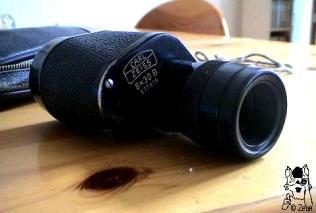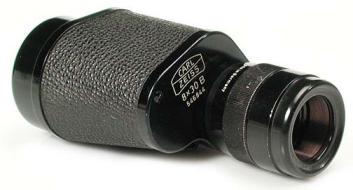Carl Zeiss 8x30 B
Dies war in den 70er Jahren mein erstes Monokular, dass ich geschenkt bekam und benutzt habe. Das Glas wurde allerdings zwischen 1958 und 1964 produziert. |
This was my first monocular in the 1970s which was given to me and that I used for a long time. Actually, the glass was produced between 1958 and 1964. It weighs 220g and fits in the palm of a hand (length: 89mm without 10cm with eye-cup). As you can unscrew the eye cup, you could use it as a telephot-lens with a 27mm thread. You can find pictures of the CZ 8x30B porro prism successor model for use with the Zeiss cameras here. |


Beide abgebildeten Modelle (Ser.Nr. 537918; 646644) haben eine Hartgummi-Augenmuschel, die sich nicht zurückklappen lässt. Laut Gebrauchsanweisung (G52-009, XI 59) gab es für das 8x30B 1, 2, 3, 5, 8dpt Vorsatzlinsen, wobei mit der 8dpt Linse ein Herangehen von 11cm bei einer 3,6fachen Vergrößerung möglich war. |
Both specimen depicted here (S/N. 537918; 646644) have hard rubber eye-cups, which cannot be folded down. According to the manual (G52-009, XI 59) 1, 2, 3, 5, 8dpt close-up lenses were available for the 8x30B. With the 8dpt lens you could focus as close as 11cm and have a 3.6x magnification. |
Foto: Zeun

